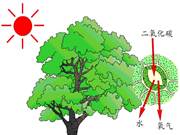
We all enjoy the beautiful show of colours as leaves change each autumn. But did you ever wonder how and why this happens?
Leaves are nature’s food factories. Plants take water from the ground through their roots and take carbon dioxide (二氧化碳) from the air. Plants use sunlight to turn water and carbon dioxide into glucose (葡萄糖). Glucose is a kind of sugar, which plants use as food for energy and growing.
The way plants turn water and carbon dioxide into sugar is called photosynthesis that means “ putting together with light”. A chemical called chlorophyll helps photosynthesis. It gives plants their green colour. As summer ends and autumn comes, the days get shorter and shorter, and trees “know” to begin getting ready for winter.
During winter, there is not enough light or water for photosynthesis. Trees rest during this time and live on the food they store during the summer. They begin to shut down their food-making factories.
As the green chlorophyll disappears from the leaves, we begin to see yellow and orange leaves. Small amounts of these colours have been in the leaves all along. We just can’t see them in the summer, because they are covered up by the green chlorophyll.
The bright reds and purples we see in leaves are made mostly in autumn. In some trees, like maples (枫树), glucose is caught in the leaves after photosynthesis stops. Sunlight and the cool nights of autumn turn this glucose into a red colour. The brown colour of trees like oaks (橡树) is made from waste left in the leaves.
It is the mixture of all these things that makes the beautiful colours we enjoy during autumn.
小题1:The word “chlorophyll” in the third paragraph means _______ in Chinese.
小题2:The leaves of the trees in autumn turn yellow because of the short of _____.
| A.water and carbon dioxide |
| B.glucose and energy |
| C.sunlight and water |
| D.sunlight and carbon dioxide |
小题3:The way that _______________________ is called Photosynthesis .
| A.plants change water and carbon dioxide into sugar |
| B.plants turn water and carbon dioxide into sugar with the help of sunlight |
| C.plants use glucose as food for energy and growing |
| D.chlorophyll is a great help |
小题4:Which of the following is NOT true?
| A.When autumn and winter come, the days get shorter and shorter. |
| B.During winter trees rest and live on the food they store during the summer. |
| C.During winter small amounts of yellow and orange colours are kept in the leaves all the time. |
| D.Trees begin to stop making food in summer. |
小题5:This passage tells us __________________.
| A.all the plants can grow well with the strong sunlight |
| B.there are all kinds of plants on the earth |
| C.all the colours of the leaves aren’t made from chlorophyll |
| D.maples and oaks have the same reason as other trees for the change of colours |